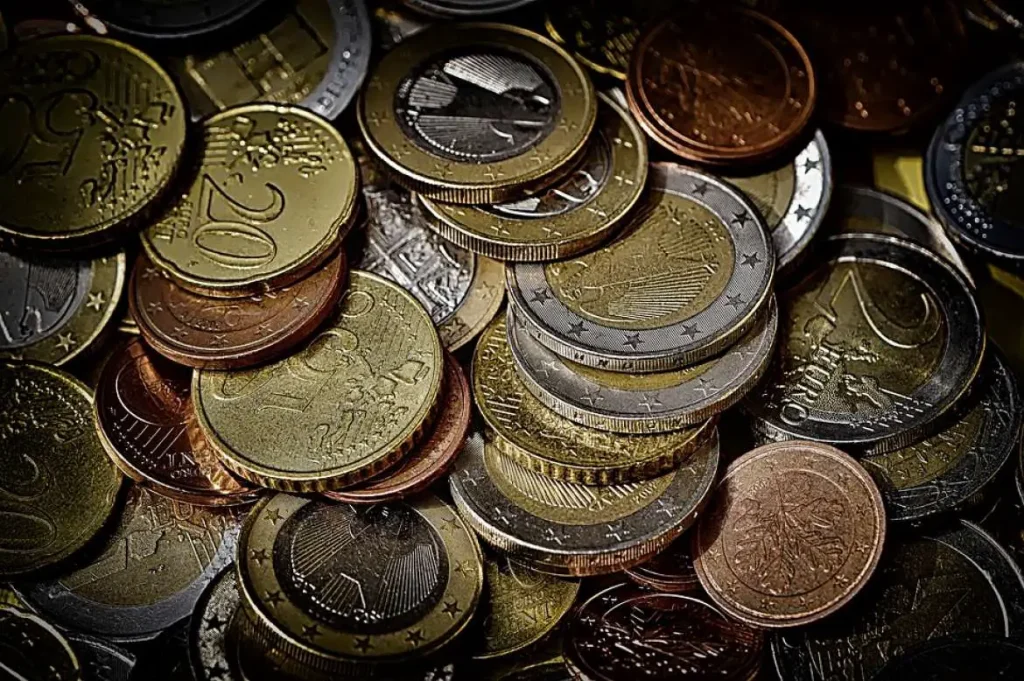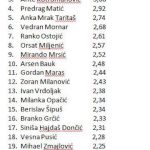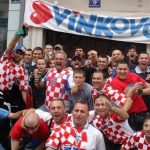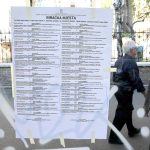April the 28th, 2023 – This week in Croatian politics, we’ve had talks about everything from reforms to petrol prices, inflation and wages, to popularity contests and a decreasing number of undecided voters.
Plenkovic talks reforms, Ukrainian soldiers being treated for injuries in Croatia, and more
As Index reports, the latest government session was held yesterday, and Prime Minister Andrej Plenkovic addressed the public at the beginning.
In the introductory part of the session, the Prime Minister referred to current events, recalling the meeting with the Secretary General of the OECD Mathias Cormann, and its overall importance. He also singled out his recent visit to Osijek, where a large economic centre was opened, representing an investment of 10 million euros.
“Yesterday, those from Ukraine who have been wounded arrived in Croatia, they’ve all been being taken care of, and I’d like to wish them a steady recovery,” he said.
“A government meeting was held and as a result, petrol and diesel became cheaper. Without government measures, fuel would be twenty cents per litre more expensive,” he added.
“We’ve now adoptedthe national reform programme. We have 56 permanent measures, and some more measures have been added in various areas for good measure. The adoption of the stability programme document is particularly important. The main backbone of economic policy in the coming period will be the responsible management of public finances. We’ve gained credibility. The goal is to increase the growth of the economy, to be on the trail of two major directions – climate policy and digital transformation,” he said, and when discussing the country’s fiscal policy, he added that he would concentrate on reducing the public debt.
“Our projections for the medium-term period are realistic. Last year we achieved growth of 6.3 percent and provided numerous aid packages to members of the public. We gave more than 6 billion euros in aid to the public and the economy. Due to excess income at the local community level, we achieved a budget surplus of 4 percent of GDP – and we reduced public debt last year as well,” he added.
“Croatia is the only country that has had its credit rating raised by all three agencies since the beginning of the Russian invasion of Ukraine. The next period will be marked by uncertainty, but we can realistically expect the Croatian economy to grow by 2.2 percent this year. We can predict this based on the excellent results in tourism so far and this will be a record year. As for the stability pact, we’ve met all the criteria. As for inflation, we expect a slowdown to 6.6 percent, and in the coming years we expect a significant slowdown to previous levels.”
Inflation and wage increases (or a lack of) were discussed on Otvoreno by politicians from across the spectrum, and the CNB’s deputy governor, Sandra Svaljek
When will price growth in Croatia stop? Is inflation imported or is it the result of domestic issues? Why does the CNB governor claim that salaries in Croatia today are growing faster than inflation is rising? Whose wages are rising and by how much, and who is on the verge of poverty? How can protect the standards the public is used to? All of the above was discussed on a recent episode of HRT’s Otvoreno (Open). The present guests were Sandra Bencic (Mozemo!/We Can!), Marko Pavic (HDZ), Branko Grcic (SDP) and the deputy governor of the Croatian National Bank (CNB) Sandra Svaljek.
Bencic: Salaries are now lower in real terms than they have been back during previous years
Sandra Bencic (Mozemo) said that recently in the Croatian Parliament, they criticised CNB Governor Boris Vujcic for the lack of timely information from the CNB last autumn.
“Recently, at an international gathering, the governor presented data that clearly proved that a significant part of the inflation we have here in Croatia is driven by the growth of margins, and that the growth of margins in that share of total inflation has 5.1 points, while wage growth stands at 1.5. This shows that the margins have grown a lot more quickly and contributed much more to overall inflation than wage growth has.”
“On the contrary, we know that the growth of wages didn’t follow inflation and that they fell in real terms back in 2022. This means that if the amount increased nominally, you could buy less than you could before. Even today, wages are lower in real terms than they were in previous years,” she added.
“What we asked at the press conference is that if margins drive inflation the most in Croatia and if the fact is that more than 8% of the 12% inflation we had is domestic inflation, not imported inflation, then the measures to suppress inflation must be different. In such a case, the issue of tax on extra profits cannot be limited to the profits made in 2022, but now we have to make changes to the law on extra profit to signal to those who will make that extra profit that they will be taxed on it. But that can’t be implemented across all sectors equally as it was back in 2022, but instead it should be implemented on those sectors that increased their margins the most, and thus contributed the most to inflation, and it seems that these are the trade and accommodation sectors,” Bencic pointed out.
Pavic: Croatia has avoided a technical recession and we expect a clear economic momentum
Marko Pavic (HDZ) said that while appearing on Otvoreno, they had the opportunity, among other things, to discuss the governor’s report in parliament, as well as the results of the government’s policy in curbing inflation.
“What should definitely be pointed out is that the government has introduced four packages so far, the last of which is worth 1.7 billion euros. The goal was to reduce energy prices, I’d like to remind you that we have electricity and gas prices 2 to 3 times cheaper than the market price, to protect people from inflation and to prevent a social fracture for those who are the most vulnerable, primarily pensioners, unemployed people, young people and children, all of whom are vulnerable groups in our society,” Pavic said.
“This has led to good results, inflation has been slowing down over the last four months and according to the data of the National Bureau of Statistics, the average salary has exceeded to 1,106 euros. Over the last 6 years, accumulated inflation has stood at 16.4%, of which 10.1% was last year, but salaries have grown by 30%, pensions by 28%, and the minimum wage by almost 70%. Croatia has avoided a technical recession and we expect a clear economic momentum,” Pavic pointed out.
“As for the law on extra profit, we passed it precisely because of price manipulations. It brought several hundred million euros back into the state budget,” he added.
Grcic: Employees are being neglected in terms of the distribution of higher GDP
Branko Grcic (SDP) said that he would refer back to the data that Pavic is talking about, which is full of illogicality.
“Here in this study, six months ago I warned people, about a radical change in distribution in Croatia. This has now been shown by the data and analysts from other countries in our environment. You have a situation where your GDP grew by over 6% in real terms last year. At the same time, you have a real decline in terms of salaries, and we don’t agree with that. The data clearly shows that the employees themselves were neglected in that distribution and that the higher GDP that was actually achieved went somewhere else.
That’s what I said 6 months ago here, when not many people were talking about it. In fact, there’s nowhere to go but to the two sources that make up the GDP structure. These are government revenues (taxes and contributions) and profit. It’s clear that if the state has roughly followed the GDP, those who create profits have profited. “Profit is not the shameful thing, the shameful thing is that some people in Croatia simply cannot live on their incomes, whether they’re salaries or pensions,” said Grcic.
“The data for the six years that Pavic is talking about is very clear. From the government’s presentation, which was released to the public a few weeks ago, it’s clear that GDP has grown by 25% in real terms over the last six years, while wages have only increased by 15% and pensions by only 6.7%. I’m talking about reliable data from the government’s presentation. So you’re actually mixing nominal categories with real categories,” Grcic emphasised.
“That’s the key problem facing Croatia. It has so happened that many people have used inflation to pump their own profits. If that profit will go into investments tomorrow, that’s good. If that profit will be repatriated, if it will leave Croatia, if it will be enjoyed some foreign owner who has a company in Croatia, and not by the Croatian people, then this is a problem.” Grcic concluded.
The latest Crobarometer survey reveals that HDZ is still the favourite party, and that President Zoran Milanovic (SDP) is seen in the most positive light
As Index reports, the Crobarometer monthly survey for April by Dnevnik Nova TV has now been published. The research results reflect the period of the end of the previous month and the first half of the current month.
The Crobarometer results for April shows that inflation, i.e. the rise in the prices of certain products and services, remains an important topic in the public space and in the everyday life of the general public. In addition, healthcare remains in sharp focus. The justice sector was also partly in the public’s focus with the announcement of changes in how it functions. With Easter and the first major arrival of tourists out of the way, topics related to tourism have now, in their seasonal pattern, become reborn. Optimism increased slightly in April and is at a similar level as it was back at the end of last year and in January this year.
HDZ still has over 30 percent of public support as a party
The survey shows that HDZ has firmly consolidated its support and it hasn’t fallen below thirty percent. It remained very much the same throughout the month of April, and it currently enjoys 30.9 percent support. That said, seems that the SDP is also somewhat cautiously recovering. SDP’s level public support stands at at 13.6 percent, 1.5 percentage points more than last month, and, what is even more important for that party, is that their rating has been slowly growing for the third month in a row now.
In third place is the Mozemo! (We Can!) party with 8.8 percent, with a similar growth and trend as SDP. The fourth is Most (Bridge) with 8.7 percent support, also recording a positive trend, while in fifth place sits Domovinski pokret (Homeland Movement) with a slightly negative trend and a mere 6 percent support.
The parties that haven’t even crossed the electoral threshold and enjoy more than 1 percent of support are IDS, Centar, Blok imirovljeni zažene, HNS and HSU. All the others, including parliamentary parties such as the Social Democrats, HSLS or Sovereignists, have less than 1 percent of recorded public support.
There’s been a visible decline in the number of undecided voters
The secret of the growth of the aforementioned parties, it seems, is the decline in the number of undecided voters. Although they’re still the second political force in the country, that number is decreasing and now 17 percent of respondents who would certainly or probably go to the polls don’t know who they’d choose to vote for. Just one month earlier, that number stood at a concerning 19.2 percent.
It also seems that the parties of the left and centre left, SDP and Mozemo, grabbed the most people from that pool over the last month, which indicates the only way in which one can try to counter HDZ is to consolidate their base and seek space among the undecided.
As for how many people would go to the polls if they were held today, judging by the respondents, the turnout would be decent: 68 percent of them would definitely or very likely go to the polls to vote. 27 percent of them would certainly or probably boycott the elections, while five percent of those surveyed had no opinion on it whatsoever.
Which politicians are the most popular?
The public perceives President Zoran Milanovic in the most positive light, despite his bizarre ”politically damaging” statements and somewhat odd behaviour at times. In second place this month is Zagreb Mayor Tomislav Tomasevic, followed by Bozo Petrov, in fourth place is Ivan Penava and in fifth is Prime Minister Andrej Plenkovic.
Unsurprisingly, the public has the most negative impression of Milorad Pupovac, followed by Gordan Jandrokovic and Zlatko Hasanbegovic in joint second place, and Prime Minister Plenkovic and Hrvoje Zekanovic tied for third place. If you look at the net ratio of negative to positive experiences, Tomislav Tomasevic is the best, second place is shared by Bozo Petrov and Ivica Puljak, fourth is Ivan Penava, and fifth is President Milanovic.
Support for both President Milanovic (SDP) and Plenkovic’s government (HDZ) is growing
After his support fell for four months in a row, Milanovic has successfully managed to reverse that trend. Namely, 56 percent of respondents who don’t support his work decreased to 53 percent, while the number of those who support him increased from 36 to 38 percent.
There has also been a change in the trend regarding support for the work of the government itself. After a slight but constant three-month increase in the number of respondents who claimed not to support the moves made by the government, there’s also been a change. The number of such people decreased from 65 down to 61 percent, while the number of those who support the work of the government increased from 28 to 30 percent.
Labour Minister Marin Piletic was a guest of Romano Bolkovic’s popular 1 on 1 (jedan na jedan) show, where he claimed that the Croatian labour market is becoming more and more interesting
Labour Minister Marin Piletic was a recent guest of Roman Bolkovic’s show “1 on 1” on HRT, where he spike about the dynamics of unemployment and employment across the country. Minister Marin Piletic also presented the data he had on the number of residence and work permits issued to foreign workers.
“With regard to the legal changes from 2021, in 2022 we had a record number of foreign workers in Croatia, more than 124,000 of them received a permit to stay and work here legally,” he said, adding that it’s still the case that the most foreign workers in Croatia mostly come from Bosnia and Herzegovina, Serbia, Macedonia and Nepal.
According to Piletic, the fact that Croatia has reached the figure of 124,000 foreign workers in Croatia from the quota system is in favour of the fact that Croatia is becoming an interesting labour market.
”We’re aware of all the challenges we’re dealing with, with the number of people who have temporarily or permanently left the country following liberalisation and the opening of the EU’s doors to Croatia, and based on the demands of employers, but also the real needs of the labour market, it was possible for 124,000 foreign workers to find happiness in Croatia. In 2023, we’ve had more than 40,000 requests for the issuance of permits for residence and work in Croatia,” he stated when discussing the current data.
When asked how Croatia might work harder to try and retain the best quality people, in whom the most was invested through education, Piletic answered: “Only with an adequate price offered to them for their work. Since 2016, the average salary in Croatia has been growing rapidly,” pointed out Piletic.
Negotiations with trade unions
”The average net salary in Croatia is now 1,106 euros, but the government is continuing to do everything it can to make the price of labour higher. Among other things, we reopened collective negotiations with representative unions,” said the minister, noting that last year, the base increased twice and that on April the 1st of this year, in accordance with the agreement and the collective agreement, the base rate increased by two percent. He added that negotiations will continue after the summer tourist season is over, when the possibility will open again that the price of labour, through the increase of the base, will be higher.
For more on Croatian politics, make sure to keep up with our dedicated section. A dedicated Week in Croatian Politics article is also published every Friday.










